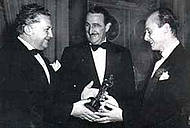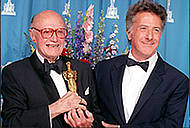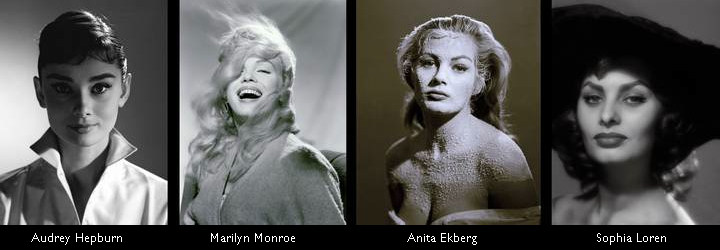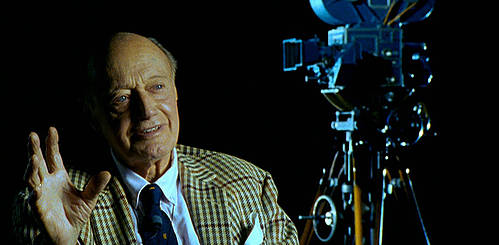“Who Is Jack Cardiff?”

- 1929

- 1947: Jack accepting his Oscar® for Black Narcissus

- 2001: Jack receiving the Honorary Oscar® for Lifetime Achievement
Jack Cardiff was lauded by the Hollywood greats he photographed films for — John Huston, Sophia Loren, Alfred Hitchcock, Marilyn Monroe — and described by Michael Powell as “A genius, a daydreamer, a baby. He should have been a painter instead of being the best colour cameraman in the world.” Yet he has remained largely unknown to the general public until now.
Cameraman celebrates the life and work of this unique figure in British and international cinema, a man whose career spans an incredible nine decades of cinema history. “Legend” is a word all too frequently used in Hollywood, yet Jack Cardiff’s story surely proves him worthy of that title.
In 2001, fifty-four years after first winning an Academy Award for his stunning Technicolor work on Black Narcissus, Jack Cardiff became the first cinematographer to receive an honorary, Lifetime Achievement Oscar® for: “Exceptional contributions to the state of motion picture arts and sciences; and for outstanding services to the Academy.”
Jack began in the film industry in 1918 as a child actor aged just four, but quickly switched to the other side of the camera, graduating to cinematography and for a period direction, gaining over a hundred film credits on productions as diverse as The Red Shoes and Rambo. In the process Jack Cardiff had a profound and lasting influence on cinema and its current leading practitioners.

The Story

In this unique insight into his life and work, we reveal how Jack elevated Technicolor photography to an art form and made history with his groundbreaking vision and technical wizardry in A Matter Of Life And Death, The Red Shoes, The African Queen and many, many other productions.
Martin Scorsese guides us through Jack’s films, explaining why they had such a dramatic and personal impact on him and his peers. “I began to have a very strong affinity towards British cinema because of my recognition of Jack’s name.”

- 1948: The Red Shoes. Still copyright © ITV Global Entertainment Ltd.
Scorsese personally oversaw the recent restoration of The Red Shoes, a film he first saw when he was eight years old. “I wouldn’t know how to begin to explain what this film has meant to me over the years. It’s about the joy and exuberance of film-making itself... one of the true miracles of film history.”
Director Craig McCall avoids the use of voiceover in the film, relying on those who made the movies to tell Jack’s story. Featuring unique interviews with over twenty of the world’s greatest actors, directors and technicians, Cameraman is not only a valuable testimony to British and international cinema history; it’s an informative and sometimes humorous one too — an amazing story about an exceptional life.
Behind The Scenes

- Jack with his 16mm Bell & Howell

- The African Queen on location
After filming Pandora and the Flying Dutchman (1951), director Albert Lewin gifted Jack with a Bell & Howell 16mm camera. This clockwork "home movie" camera would be witness to many candid moments with the casts and crews of numerous productions.
Cameraman includes some of this never-before-seen footage which reveals the difficulties and dangers the filmmakers faced while making the The African Queen in the Congo and The Vikings in the Norwegian fjords, as well as lighter moments with Sophia Loren, John Wayne, Kirk Douglas and Errol Flynn.

Actress Portraits

Icons are made, not born. In Cameraman, Jack Cardiff looks back on his working relationship with some of cinema’s most enduring screen legends —Ava Gardner, Ingrid Bergman, Marlene Dietrich, Sophia Loren, Audrey Hepburn and Marilyn Monroe — and unveils the photographic portraits he took of them in private sittings.
There were two sides to Jack, wrote Philip French: “One the pipe-smoking, practical man, the other the great romantic, fascinated by the relationship between cinematographer and star, a continuation in an infinitely more complex way of the intimacy between artist and model."

The Artist

Today, filmmakers rely on digital manipulation for effects the camera cannot capture. Inspired by classical art and modern Impressionism, given free creative license in the trio of movies he made for Powell and Pressburger, Jack Cardiff became a wizard of in-camera effects. Together with the Archers’s crew he recreated the Himalayas in the studio (Black Narcissus); he breathed on the lens to create fog for Michael Powell (A Matter Of Life and Death); for King Vidor’s epic War & Peace he painted grand winterscapes on glass; and on Conan The Barbarian (1982) he was still working magic by livening a grey sky with his box of paints for producer Raffaella de Laurentiis.

Always an innovator and always looking forward, Jack was never precious about the past. “Sometimes in an effort to be kind, people say to me: oh, Jack, they don’t make films like those Technicolor films. But I think the standard of modern British cinematography keeps improving. I get jealous sometimes when I see what they’re doing.”
Jack Cardiff died in April 2009 aged 94, leaving behind a wealth of work which will live on for generations to come.
